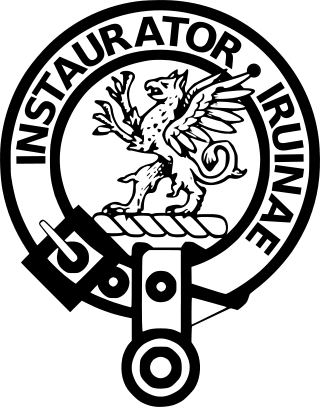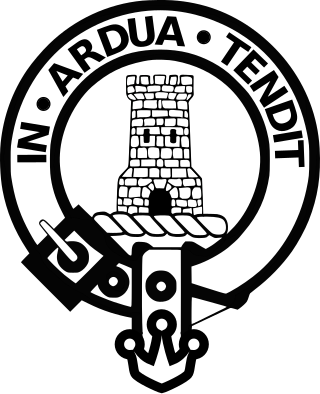
The World Wide Web (WWW), commonly known as the Web, is an information system enabling documents and other web resources to be accessed over the Internet.
Rates are a type of property tax system in the United Kingdom, and in places with systems deriving from the British one, the proceeds of which are used to fund local government. Some other countries have taxes with a more or less comparable role, like France's taxe d'habitation.

Lanercost Priory was founded by Robert de Vaux between 1165 and 1174, the most likely date being 1169, to house Augustinian canons. The priory is situated at the village of Lanercost, Cumbria, England, within sight of Naworth Castle, with which it had close connections. The Lanercost Chronicle, a thirteenth-century history of England and the Wars of Scottish Independence, was compiled by the monks of the priory.

Clan Agnew is a Scottish clan from Galloway in the Scottish Lowlands.

Menstrie is a village in the county of Clackmannanshire in Scotland. It is about five miles east-northeast of Stirling and is one of a string of towns that, because of their location at the foothill base of the Ochil Hills, are collectively referred to as the Hillfoots Villages or simply The Hillfoots.
Laird is the owner of a large, long-established Scottish estate. In the traditional Scottish order of precedence, a laird ranked below a baron and above a gentleman. This rank was held only by those lairds holding official recognition in a territorial designation by the Lord Lyon King of Arms. They are usually styled [name] [surname] of [lairdship]. However, since "laird" is a courtesy title, it has no formal status in law.
Land registration is any of various systems by which matters concerning ownership, possession, or other rights in land are formally recorded to provide evidence of title, facilitate transactions, and prevent unlawful disposal. The information recorded and the protection provided by land registration varies widely by jurisdiction.

Gogar is a predominantly rural area of Edinburgh, Scotland, located to the west of the city. It is not far from Gogarloch, Edinburgh Park and Maybury. The Fife Circle Line is to the north.
RDFa or Resource Description Framework in Attributes is a W3C Recommendation that adds a set of attribute-level extensions to HTML, XHTML and various XML-based document types for embedding rich metadata within Web documents. The Resource Description Framework (RDF) data-model mapping enables its use for embedding RDF subject-predicate-object expressions within XHTML documents. It also enables the extraction of RDF model triples by compliant user agents.

Clan Forsyth is a Scottish clan.

Clan Lumsden is a Lowland Scottish clan.

A bee bole is a cavity or alcove in a wall for bee keeping.

Clan Jardine is a Scottish clan of the Scottish Lowlands.

The Clan Malcolm, also known as the Clan MacCallum, is a Highland Scottish clan. The Clan MacCallum may have originally been a separate clan until the 18th century, when the chief of the Clan MacCallum adopted the name Malcolm after inheriting the Malcolm estate, and the two clans were drawn together under the same chief.

Haugh of Urr, is a village in the historical county of Kirkcudbrightshire in Dumfries and Galloway, Scotland. It is approximately 4 miles NNW of Dalbeattie, 3 mi (5 km) NE of Castle Douglas, 12+1⁄2 mi (20 km) west of Dumfries and 12+1⁄2 mi (20 km) east of Kirkcudbright.
Inchtavannach, is one of the larger islands in Loch Lomond.
Microdata is a WHATWG HTML specification used to nest metadata within existing content on web pages. Search engines, web crawlers, and browsers can extract and process Microdata from a web page and use it to provide a richer browsing experience for users. Search engines benefit greatly from direct access to this structured data because it allows them to understand the information on web pages and provide more relevant results to users. Microdata uses a supporting vocabulary to describe an item and name-value pairs to assign values to its properties. Microdata is an attempt to provide a simpler way of annotating HTML elements with machine-readable tags than the similar approaches of using RDFa and microformats.
The Yates County Genealogical and Historical Society focuses on the history of Yates County, New York. It operates the Yates History Center, which consists of three museums in the village of Penn Yan, New York: the 19th century period Oliver House Museum, the L. Caroline Underwood Museum with historic decorative arts items and displays of local history, and the adjacent Scherer Carriage House which features exhibits about the local evangelist known as the Public Universal Friend.

The Boles Fire was a wildfire that burned in Siskiyou County during mid-September 2014. On September 15, at 1:38 p.m. PDT, the Boles Fire ignited near Weed, California. Later on the same day, at 10:30 p.m. PDT, the Boles Fire was reported at 350 acres and 15% containment. Over 100 structures were reported damaged or destroyed on that day. Later that day, the wildfire was reported at nearly 100% containment; however, this report turned out to be erroneous. On September 16, the Boles Fire had burned 375 acres (152 ha) and was only 20% contained. It also destroyed 150 residences and forced the evacuation of 1,500 people in Weed and Siskiyou County.

Nantwich Walled Garden is a disused walled garden in the town of Nantwich, Cheshire, UK. It occupies approximately half an acre north of 82 to 96 Welsh Row.













